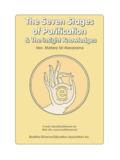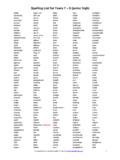Transcription of Honeybees-Interesting Facts - Notice Nature
1 WL 8. WILDLIFE. information on the environment / eolas ar an gcomhshaol Honeybees-Interesting Facts The Honeybee belongs to the months in winter and early spring. insect order Hymenoptera, which All worker bees are females order contains many thousands of (infertile) and are smaller than the species of bees, wasps, ants and queen. The young worker bees many groups of parasitic insects. remain in the hive for two weeks where they are involved in The bee has been known to the Worker cleaning empty cells, caring for the human race for many thousands of young, building comb and years. There is a very old processing the incoming nectar. educational painting in a rock When the worker is 10 - 14 days shelter in Spain depicting bees. old, it flies to the field where it Stone Age man ate honey which forages, collecting nectar, pollen he stole from the nests of wild and water and then returns to the bees.
2 Bees were first kept by man Drone hive. in hollow logs with sticks to support the honey combs. Later Some worker bees perform guard man kept bees in straw baskets duty at the hive entrance called skeps' and today, bees are defending the hive against kept in standard hives. strangers; other workers at the entrance fan fresh air into the hive There are about 10,000 species of and force out stale air. The bees which roughly are divided Queen movement of the workers' wings into two main groups: Social Bees Three kinds of bees make up a help to produce enough heat to that live in colonies and Solitary honey bee colony. The colony keep the colony of bees at an even Bees that live alone. consists of thousands of temperature. The sting of a worker Feithid s isialta at sna Beacha workers, one queen and few bee is straight, with barks or hooks Meala.
3 C na onn agus saothra onn hundred drones. on it. Bees depend on their sting as siad le ch ile i ngr pa m ra a their only means of self defence dtugtar coil neachta mar ainm and will only sting when they feel orthu. Is mar seo a leanas leagan The QUEEN honeybee lays the eggs they are under threat. amach na gcoil neachta : that hatch into thousands of DRONES are the male honeybees A QUEEN (the reproductive young bees. Laying eggs is the and are large burly clumsy female) queen's only function, she does not creatures with hairy bodies and gather food or build honeycomb. large eyes. They develop from The WORKERS (infertile females) Queens can live for 3 - 4 years and unfertilized eggs and their only numbering about 10,000 in may lay up to 2,000 eggs per day function is to mate with young winter and increasing to about at a peak time. The queen has a queens.
4 After mating the drones 60,000 in mid summer smooth curved sting which she die. They have no sting and are DRONES (male bees) numbering uses only to kill rival queens. unable to defend themselves 200 - 1,000 approximately and The WORKERS do all the work in against workers who ruthlessly are present in the colony mainly the colony. They live for about 6 force them out of the hive when during the summer month weeks in summer and up to 6 there is a scarcity of food and at the start of the winter period. it's easy | to make a difference ENVIRONMENTALLY FRIENDLY GARDENING / Honeybees: Interesting Facts / WL 8. Bee larvae Honey is presented in many forms: Beeswax Bees like other insects are LIQUID HONEY: this honey is Beeswax is a by-product of produced from eggs. The queen extracted from the combs and is beekeeping and is a highly lays one egg in each cell of the sold in glass jars.
5 It is available in valuable product. It has many uses comb. The eggs are very small, many different colours depending candle making, polishes, art, pearly white, visible to the naked on the flowers used by the bee. cosmetics. It is used in beekeeping eye. After three days a tiny COMB HONEY: is honey stored by as foundation in frames to wormlike larva hatches from each bees in the cells of freshly built encourage bees to build comb. egg. It is fed for three days on food comb and is sold as sections or Beeswax is produced by bees from produced from the head glands of pieces of cut comb in plastic their own bodies. Worker bees have the worker bees. When the larva is containers. four pairs of wax glands on the three days old, it is fed a mixture of CHUNK HONEY: is liquid honey underside of their abdomens. The honey and pollen. Five days after with one or more pieces of comb wax oozes through these glands the larvae hatches, the worker bee honey and is sold in glass jars.
6 And forms tiny flakes or scales on builds a wax cap over the cell. In the outside of the abdomen. The it's sealed cell the larvae changes CREAMED HONEY: all honeys flakes are then passed to the bee's into a pupa, then the pupa granulate or crystallise with time. jaws. The flakes are then chewed develops into an adult bee. The When the rate of crystallisation is and other materials may be added adult worker bee bites it's way out controlled, a creamed honey is to them. When they are soft, the of the cell 21 days after the egg is obtained. Creamed honey is bee puts the wax on the part of laid. The drone takes 24 days and suitable as a spread. the comb that it is constructing. the queen 16 days. Wax is produced usually by young Nectar is an essential food for bees Honey - what is it and how worker bees about 10 to 16 days and can be used immediately to old, but in an emergency older is it made?
7 Feed bees. If it is not used at once bees can also do the work. The the bees will store nectar as honey From the human point of view, bees produce wax only when it is for use later. If the bees have more honey is the prime product of the needed to build the honeycomb. honey than they need, the honeybee. Honey is a foodstuff, beekeeper will remove the surplus Wax can only be made if the bees which is produced by the honeybee honey for his own use. are very warm. In order to obtain from the nectar of blossoms, which this warmth, the bees cluster bees collect, transform, combine with specific substances of their By-products of the hive together on the comb they are building. The hexagonal shape of own, and store and leave in Propolis the honey comb cells constructed honeycombs. Bees use the honey to Propolis is a by-product of the hive. with remarkable precision and feed the larvae during the winter.
8 It is a sticky substance collected by regularity ensures the least waste Flowers have special glands called the worker bees from the buds of of space and material. A. nectaries that produce nectar. various plants and trees honeycomb has walls that are only Nectar is the sweet liquid which chestnut, laurels, etc. They carry it one eightieth of an inch thick, but plants produce to attract insects for back to the hive on their hind legs. can support 30 times their own pollination. It consists of sugars It is not a food, but a building weight. dissolved in water. Honeybees suck material. It is used as a type of up nectar from the nectaries of the cement' to seal any cracks or When the beekeeper uncaps flower with their long tongues and crevices in the hive. It is also used honeycombs to recover honey, he store it in their honey sacs. When in the construction of combs to collects the wax cappings and any the honeybee has filled it's honey give added strength.
9 The bees will other unusable comb. These he sac with nectar, it returns to the use propolis to encase and seal any heats in water and the wax rises to hive. In the hive the bee unwanted objects in the hive too the surface. After it cools and regurgitates the nectar and passes heavy for the bees to remove a hardens, the cake of wax is it to the hive bees who put it in an mouse. The propolis prevents the removed and refined for re-use. empty cell in the hive for use as mouse from rotting and creating a needed. While the nectar is in the nasty smell. There is considerable Plant pollination bee's honey sac, it combines with evidence that propolis contains enzymes. In the honey comb the The greatest value of honeybees is antibiotic properties and is said to waterevaporates and the chemicals in their service as pollinators have beneficial effects in cases of from the bee change the nectar which far outweigh their value as sore throats, infectious wounds into honey.
10 When the honey is ripe honey producers. Pollination is the and in relieving many human the bees seal it into the cells by term used to describe the transfer complaints and sicknesses. putting wax caps on the honey of pollen from the male element of filled cells. the flower to the female element of the same flower, or to other INFORMATION ON THE ENVIRONMENT / EOLAS AR AN GCOMHSHAOL. flowers of the same species. Many The Body of a Worker Bee forewing plants are air pollinated and have no need of insects coniferous Circulatory system trees, grasses and most cereals. Thorax Fruit trees and soft fruit require simple eyes hind wing special pollinators insect pollination. It has been proven that compound heart apples, pears, plums and other eye Abdomen hardy fruits and soft fruits will antenna digestive yield a much heavier crop and a system better shaped fruit when pollen head nervous stinger pollinated by the honeybee.















